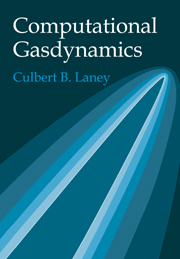Book contents
- Frontmatter
- Contents
- Preface
- Chapter 1 Introduction
- Part I Gasdynamics Review
- Part II Computational Review
- Part III Basic Principles of Computational Gasdynamics
- Part IV Basic Methods of Computational Gasdynamics
- Chapter 17 Basic Numerical Methods for Scalar Conservation Laws
- Chapter 18 Basic Numerical Methods for the Euler Equations
- Chapter 19 Boundary Treatments
- Part V Advanced Methods of Computational Gasdynamics
- Index
Chapter 18 - Basic Numerical Methods for the Euler Equations
Published online by Cambridge University Press: 07 December 2009
- Frontmatter
- Contents
- Preface
- Chapter 1 Introduction
- Part I Gasdynamics Review
- Part II Computational Review
- Part III Basic Principles of Computational Gasdynamics
- Part IV Basic Methods of Computational Gasdynamics
- Chapter 17 Basic Numerical Methods for Scalar Conservation Laws
- Chapter 18 Basic Numerical Methods for the Euler Equations
- Chapter 19 Boundary Treatments
- Part V Advanced Methods of Computational Gasdynamics
- Index
Summary
Introduction
This chapter concerns numerical methods for the Euler equations. Rather than starting from scratch, this chapter mainly converts the numerical methods for scalar conservation laws seen in the last chapter into numerical methods for the Euler equations. The approaches described here can be divided into two categories – flux approaches and wave approaches. Wave approaches can be further subdivided into two categories – flux vector splitting approaches and reconstruction–evolution approaches. Whereas flux approaches consider only fluxes, wave approaches model both fluxes and waves, and especially the interactions between various families of waves, using either flux vector splitting or Riemann solvers, which makes them more physical and accurate but also more expensive and complicated. Before continuing, the reader may wish to review pertinent material from previous chapters. In particular, in preparation for flux vector splitting, discussed in Section 18.2, the reader should review the introduction to flux splitting and wave speed splitting found in Sections 13.4 and 13.5, respectively. Furthermore, in preparation for reconstruction–evolution methods, which use real or approximate Riemann solvers, the reader should review Chapter 5 and the introduction to reconstruction–evolution methods found in Section 13.6. And, of course, the reader should not even consider reading this chapter until carefully ingesting the last chapter.
This chapter converts all of the numerical methods for scalar conservation laws seen in the last chapter, except for Fromm's method, into numerical methods for the vector Euler equations in one if not several ways. For most numerical methods, the vector versions retain most of the properties of the scalar versions.
- Type
- Chapter
- Information
- Computational Gasdynamics , pp. 351 - 429Publisher: Cambridge University PressPrint publication year: 1998



